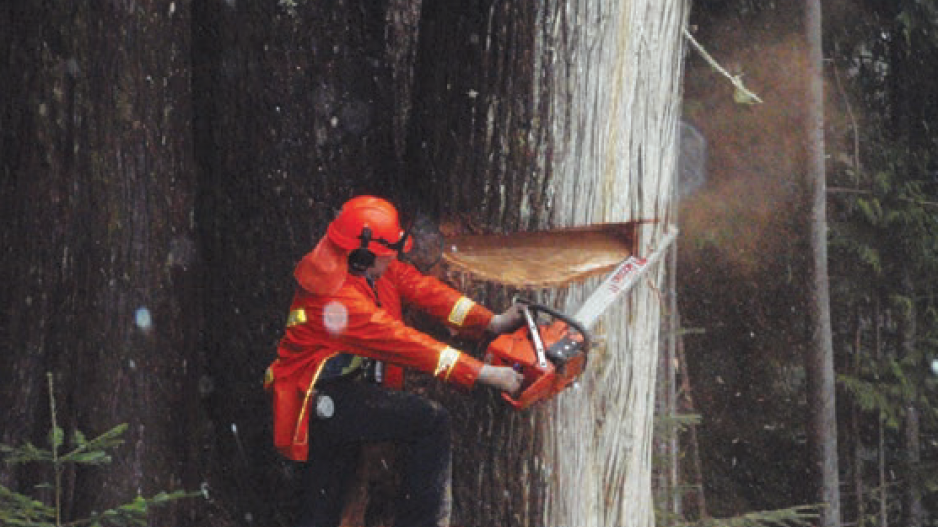A rash of deaths in B.C. forests this summer has prompted WorkSafeBC to launch an inspection “blitz” on logging operations over what it calls “outstanding and systemic safety deficiencies.”
Four forest workers died in the month of July alone – raising alarm bells among workers over what they say is a lapse in safe practices that’s putting loggers’ lives at risk.
WorkSafeBC called industry leaders together August 6 for a special meeting aimed at preventing more forest worker deaths. At the same time, it launched a month-long blitz, where inspectors visited 44 logging operations. They found enough safety violations to issue 49 orders requiring employers to bring operations into compliance with the safety regulations, and six warning letters. A warning letter puts employers on notice that further violations could result in penalties.
Faller and safe workplace advocate Jake Vandort said the number of violations discovered – even after the cluster of deaths and the emergency meeting called by WorkSafeBC – is a clear sign that there’s a problem in the bush.
“If everybody was honouring policy and procedures that have been established for a long time, and honouring regulations and law in the Workers Compensation Act, we wouldn’t be in this position,” he said of logger safety.
The cluster of deaths does not mean the industry has taken its eye off safety, said Reynold Hert, chairman of the industry-
supported BC Forest Safety Council. The fact that 25 industry leaders met in the middle of summer on short notice is proof that the industry is taking safety seriously. Eight people have died industry-wide since January 1.
This year’s death toll comes after a record low number in 2014, when only four forest workers were killed. The average rate over the last few years, however, remains stuck at eight fatalities a year, a death rate well below the average rate of 22 deaths a year prior to 2005, but still unacceptably high, Hert said.
One of the factors that workers say is creating unsafe working conditions is multi-phase logging, where fallers, road-builders, logging equipment and trucks are often operating simultaneously on a single cutblock.
Multi-phase logging has become a common practice on the coast as a way of reducing the high cost of log inventories. The time between the different phases of logging, from fallers cutting the timber to road building and yarding the logs out to trucks, has been gradually compressed to within three months, squeezing workers closer together.
Vandort said he has worked on jobs where fallers were working alongside as many as seven pieces of heavy equipment.
The practice provides companies with a quicker response time to market changes, reduces financing costs and reduces the cost of carrying inventory. But it has also led to a new, deadly term being added to the coast logger’s lexicon: phase logging congestion.
Forest safety ombudsman Roger Harris said phase congestion has raised the risk of death and injury for forest workers.
“It’s not intuitive that if you do multi-phase logging that you are unsafe,” he said. “But there’s no doubt it certainly makes it a much more complex workplace that requires significantly more communication to make sure you don’t have a problem.”
WorkSafeBC recognizes phase congestion as one of several factors requiring greater industry attention, said Al Johnson, WorkSafeBC’s vice-president of prevention services.
“Now that it’s recognized, it needs to be managed. Our expectation is, first of all, employers are aware of it and are managing it.”
Johnson, who called the August 6 meeting, said other issues, from the overall logging culture, to workers’ concerns about repercussions for refusing to do unsafe work and a renewed effort toward safety education were also discussed.
“We are worried. We know they are worried about it as well,” he said, referring to industry leaders. “The recent cluster of four worker deaths reminds us how hazardous this work is. We need to do everything we can to prevent this from continuing and to prevent deaths from occurring.”
Johnson also said concerns have been raised that safe practices put into writing at the corporate level are not being transmitted to the job site.
“Supervisors need to not only pay lip service to the processes that are in place and subscribed to, but make sure that those processes are actually happening in the field,” he said.
Despite commitments by major licensees, Vandort said on an active cutblock, congestion can result in regulations being overlooked – like a two-tree-length distance between workers or safe distances between workers and machines.
He added that cutblocks are getting smaller and the ground is getting steeper.
With more activity in a smaller space, congestion is a problem everyone has to deal with. There are good examples of properly managed sites, he said, but they require constant monitoring, assessing and communicating with all phases of workers in the block.
“We are all stuck in the same boat here. It’s a universal problem. It’s not just a faller’s problem. It’s not just a road builder’s problem, a logger’s problem or a truck driver’s problem. It’s the nature of the beast these days in the industry. We want to get that wood out and to market as fast as possible without spending any more money.”
Next week: Faller Jeremy Tanaka died July 24 on a hillside at Holberg Inlet in a tragedy that safety advocates say was a foreseeable outcome when people and heavy logging machines are squeezed too tightly together into one forest cutblock. •




